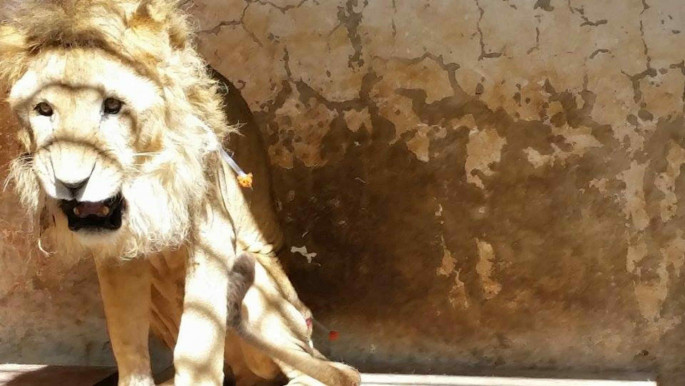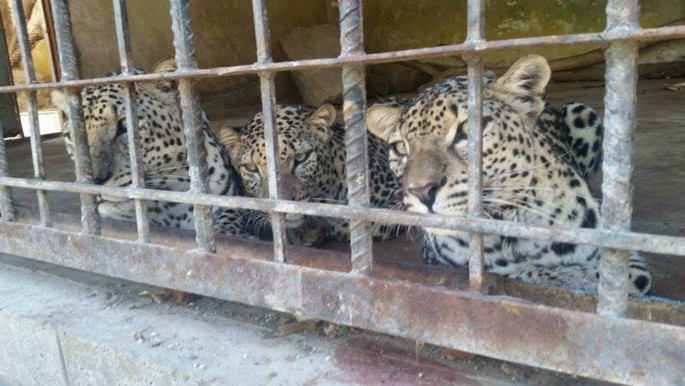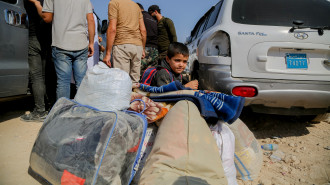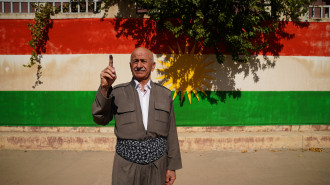Ark of endangered species on the brink in Yemen
In the besieged city of Taiz, zookeeper and sub-manager Showky al-Haj is desperately trying to save 281 animals, which are on the brink of starvation.
Many of the zoo's species are endangered, including 28 Arabian leopards, which could number as few as 45 in the wild.
Additionally, the zoo hosts 20 Barbary lions thought to be descended from the ones gifted to Yemen by Ethiopian Emperor Emperor Haile Selassie in 1953. Today the species is considered extinct in the wild.
For nearly two years the Taiz Zoo has deteriorated under the pressure of Yemen's civil war. An international coalition, led by Saudi Arabia, has imposed a sea blockade on the country targeting Houthi forces. It has resulted in a widespread humanitarian and environmental catastrophe.
"Before the war the animals used to eat and we used to receive the money and the salaries and we got to breed many animals like the Arabian leopard that is endangered… everything was great until the war came in the beginning of 2015," says al-Hajj.
"It couldn't get any worse, [the government] they couldn't provide anything so they stopped supplying, which led to the death of many of the animals. 11 lions, six leopards, most of the Arabian Oryx that are endangered, and most of the birds and other animals too."
To the rescue
The Taiz Zoo is being sustained thanks to the initiative of Kim-Michelle Broderick, a British theatre director, and actress, who has volunteered tirelessly to save the zoo's population.
She has lead the rescue effort since becoming aware of an appeal by animal welfare organization Four Paws seeking to draw attention to the dire situation in Taiz in January, 2016.
Along with international organizations and Taizi local Hisham al-Hoot, Broderick says she launched a fundraiser to provide food, water and medical supplies for the animals.
"In January as soon as I saw the announcement from Four Paws about the terrible situation at Taiz Zoo, the fact that the Zoo was abandoned, that the workers had run away because of the bombing and because they weren't paid, the animals were starving and dying in their cages and so I immediately jumped and I launched a call for anybody to come and help me."
According to Broderick her fund received little support from foreign institutions, leaving her and her teammates to provide for the zoo on their own grassroots initiative.
"No international animal organisation has accepted to give money to sustain the zoo unless we evacuate the animals.
"This is the tragedy, apart from PETA USA not a single animal organisation, conservation species welfare organisation from the IUCN to Born Free has accepted to give any money," says Broderick.
 |
| Taiz zoo hosts 20 Barbary lions thought to be descended from ones gifted to Yemen by Ethiopian Emperor Emperor Haile Selassie [Showky al-Hajj] |
An ark of the endangered
Given such realities Taiz Zoo's high population of endangered species has many animal experts worried about the fate of the sanctuary.
Marco Vittorio, director of Harimau Malaya, an NGO dedicated to the study and preservation of Malayan tigers, has been monitoring the situation at the zoo with trepidation.
"I am particularly concerned about the Arabian Leopards. Taiz Zoo is currently home to 28 individuals, 26 adults and 2 recently-born cubs, while the wild population of Arabian Leopards numbers as few as 45 to 200 specimen. So as you can imagine broad and immediate action is needed," says Vittorio.
While all the remaining individuals of a critically endangered species are vital to the continuation of the genus, Arabian Leopards, scientifically referred to as panthera pardus nimr, may be especially indispensable due to their unique evolutionary lineage.
"Concerning the importance of panthera pardus nimr," Vittorio explains, "it is strictly connected to genetic features because the Arabian leopard is considered as a separate subspecies of the leopard and it is possibly the most divergent of all mainland subspecies.
"So yes, if we lose such a unique subspecies well I think we lose a common heritage which belongs to all of us, so it would be a huge loss."
In light of these circumstances Vittorio calls for the immediate relocation and integration of the large cats into the Arabian Leopard Breeding Program in the Arabian Gulf.
"Most importantly Taiz Zoo in Yemen ceased to participate in the captive breeding program shortly after agreeing to cooperate with the regional Studbook [a breed registry] in 2001.
"Only three of the six wild-caught leopards held at Taiz zoo have bred so it is imperative that the unrepresented, wild-caught leopards in this collection and the offspring that have been bred become available to the captive breeding program to expand the currently needed bloodline stock."
 |
| Taiz Zoo is currently home to 28 Arabian leapords. Experts say only between 45 to 200 of the species exist in the wild [Showky al-Hajj] |
An uncertain future
Taiz, Yemen's third city, has witnessed fierce clashes between Houthi rebels and forces loyal to exiled president Abdrabbuh Mansur Hadi, over the past few years.
Airstrikes carried out by Saudi-led coalition aircraft in support of Hadi have also battered the city.
The city's zoo has not been spared from violence.
On at least two occasions explosions have destroyed parts of the zoo infrastructure and al-Hajj states that an Arabian oryx was killed by shrapnel during an aerial bombardment.
In order to ensure the safety of the zoo animals Broderick reports that she has organised efforts to move the animals to an alternative sanctuary for the duration of the war.
However, the task requires negotiating with both Houthi and pro-Hadi forces, which has stalled the initiative.
In December 2016 Broderick made the difficult decision to suspend funding to the zoo in an effort to pressure each side toward a more sustainable solution.
Now, the zoo animals are at greater risk of malnutrition and disease. The situation is reminiscent of January 2016 when the zoo's mascot, a leopard named Twpa'a, was seen eating the carcass of its feline cellmate, which had succumbed to starvation.
An update issued by a veterinarian Ibrahim Abdullah who visited the zoo on January 2, 2017 notes widespread malnutrition and the particularly alarming state of the bird and lion populations.
For now, the endangered animals of Taiz Zoo face an uncertain future. Without greater international support Broderick fears that "the animals will die very very shortly. They’ll just start starving and dying again like they did in 2015 up until February of 2016."
Scott Preston is a multimedia journalist based in Beirut, Lebanon, covering refugees and political topics in the Middle East.

![Palestinians mourned the victims of an Israeli strike on Deir al-Balah [Getty]](/sites/default/files/styles/image_684x385/public/2024-11/GettyImages-2182362043.jpg?h=199d8c1f&itok=xSHZFbmc)


![The law could be enforced against teachers without prior notice [Getty]](/sites/default/files/styles/image_684x385/public/2178740715.jpeg?h=a5f2f23a&itok=hnqrCS4x)
 Follow the Middle East's top stories in English at The New Arab on Google News
Follow the Middle East's top stories in English at The New Arab on Google News


